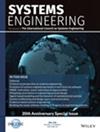Model‐based standards authoring: ISO 15288 as a case in point
IF 1.6
3区 工程技术
Q4 ENGINEERING, INDUSTRIAL
引用次数: 0
Abstract
ISO/IEC/IEEE 15288:2015 is one of the most fundamental systems engineering international standards. In this work, the major system lifecycle processes specified in 15288 and, equally importantly, the objects interacting through them, are modeled meticulously using OPM ISO 19450. The conceptual model, based on this standard's text, reflects the implied authors’ intent, bringing up ambiguities that arise from the informality of natural language text and reference to related figures. The resulting OPM model is an exact, formal, and detailed expression of the processes and related objects in the first part of 15288, making it machine interpretable. The gaps discovered during the modeling process are testimony to the value of the model‐based standards authoring approach and the centrality of a formal yet humanly accessible model as the underlying backbone of international standards and key technical documents in general.基于模型的标准编写:以ISO 15288为例
ISO/IEC/IEEE 15288:2015是最基本的系统工程国际标准之一。在这项工作中,15288中指定的主要系统生命周期过程,以及同样重要的是,通过它们交互的对象,都是使用OPM ISO 19450精心建模的。基于本标准文本的概念模型反映了隐含作者的意图,导致自然语言文本的非正式性和对相关数字的引用产生歧义。由此产生的OPM模型是15288第一部分中过程和相关对象的精确、正式和详细表达,使其具有机器可解释性。建模过程中发现的差距证明了基于模型的标准编写方法的价值,以及作为国际标准和关键技术文件的基础支柱的正式但可供人类访问的模型的中心地位。
本文章由计算机程序翻译,如有差异,请以英文原文为准。
求助全文
约1分钟内获得全文
求助全文
来源期刊

Systems Engineering
工程技术-工程:工业
CiteScore
5.10
自引率
20.00%
发文量
0
审稿时长
6 months
期刊介绍:
Systems Engineering is a discipline whose responsibility it is to create and operate technologically enabled systems that satisfy stakeholder needs throughout their life cycle. Systems engineers reduce ambiguity by clearly defining stakeholder needs and customer requirements, they focus creativity by developing a system’s architecture and design and they manage the system’s complexity over time. Considerations taken into account by systems engineers include, among others, quality, cost and schedule, risk and opportunity under uncertainty, manufacturing and realization, performance and safety during operations, training and support, as well as disposal and recycling at the end of life. The journal welcomes original submissions in the field of Systems Engineering as defined above, but also encourages contributions that take an even broader perspective including the design and operation of systems-of-systems, the application of Systems Engineering to enterprises and complex socio-technical systems, the identification, selection and development of systems engineers as well as the evolution of systems and systems-of-systems over their entire lifecycle.
Systems Engineering integrates all the disciplines and specialty groups into a coordinated team effort forming a structured development process that proceeds from concept to realization to operation. Increasingly important topics in Systems Engineering include the role of executable languages and models of systems, the concurrent use of physical and virtual prototyping, as well as the deployment of agile processes. Systems Engineering considers both the business and the technical needs of all stakeholders with the goal of providing a quality product that meets the user needs. Systems Engineering may be applied not only to products and services in the private sector but also to public infrastructures and socio-technical systems whose precise boundaries are often challenging to define.
 求助内容:
求助内容: 应助结果提醒方式:
应助结果提醒方式:


